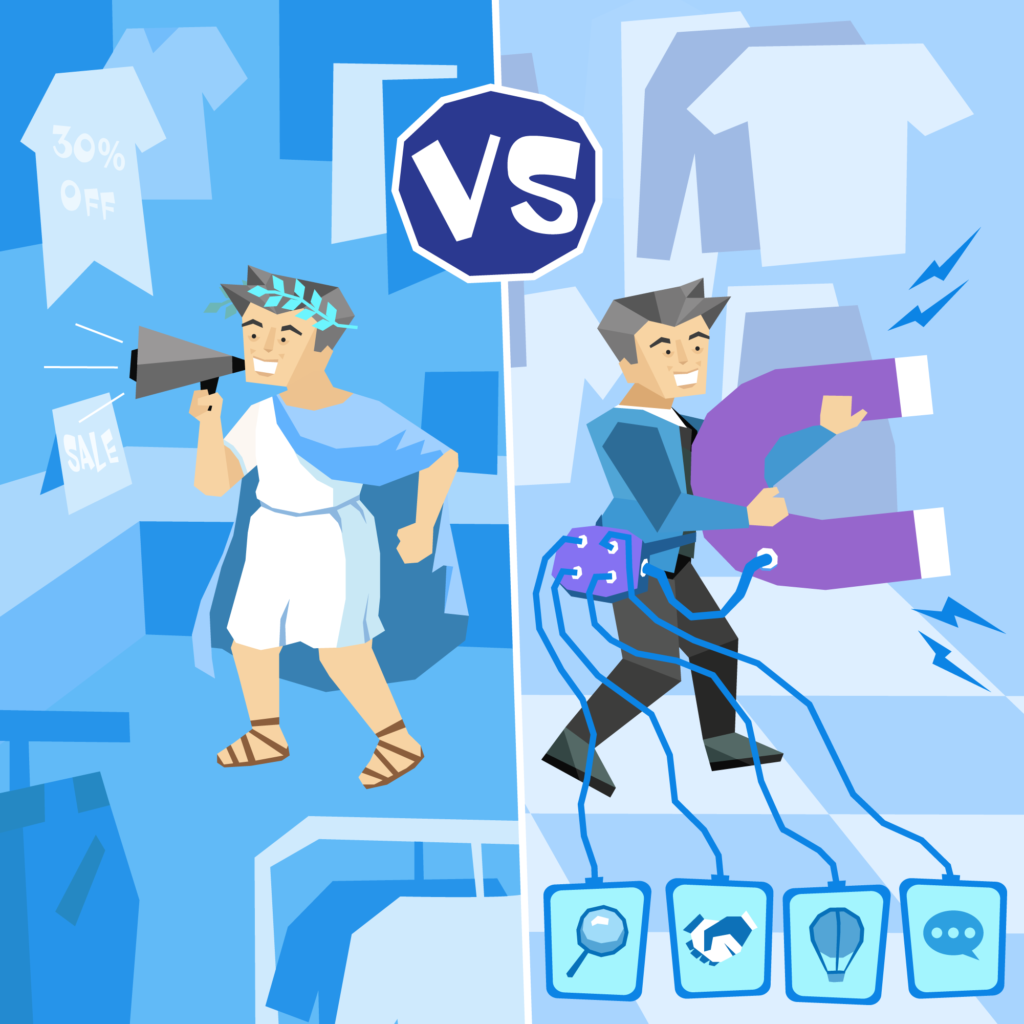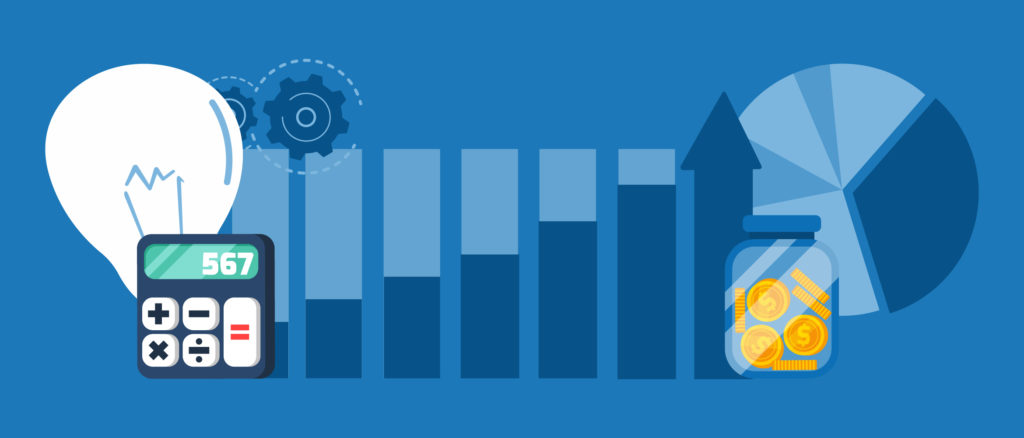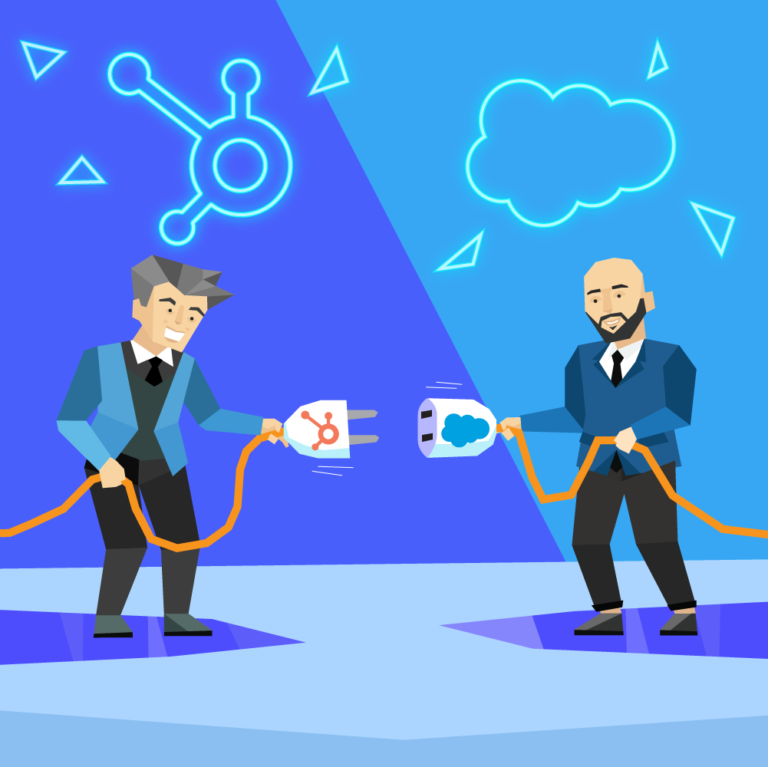The Key Distinctions Between Traditional and Inbound Sales

The way global firms, SMEs, and larger enterprises execute their critical marketing and sales workflows has changed radically over the last few decades.
While technology has continued to advance under Moore’s Law, and social media, smartphones, and the Internet, among other factors, have radically changed how prospects and leads connect and interact with businesses, the buyer’s journey (including buyer behavior) – and consequently sales and marketing techniques – has also evolved.
Key Distinctions Between The Two Types Of Sales Systems
To this end, the evolution of marketing and sales tasks, from outbound marketing to content/inbound marketing, has resulted in a distinct difference between traditional (outbound) sales versus inbound sales systems.
Inbound Marketing vs Outbound Marketing
Everything, from the initial marketing methodology to the ultimate sales result, is different when comparing traditional sales techniques and systems to inbound sales systems.
Methodology
The overall methodology with outbound sales systems revolves around reaching out to (typically) unqualified leads to quickly close a sale by convincing the lead to buy a product/service. Inbound methodologies, on the contrary, revolve around nurturing leads to become interested enough to close the sale.
Prospect Behavior
Inbound methodologies focus much more on understanding and analyzing the buyer’s journey and his/her behavior to know how to better serve him/her, and get him/her to close the sale.
Buyer Persona
Inbound sales systems are essential not only for understanding customer demographics but also for enabling marketing and sales officers to fully define their buyer personas, better understand and strategically plan the buyer’s journey throughout the sales pipeline.
Additionally, the data-driven marketing industry enables marketing and sales officers to draw more informed strategic conclusions on conversion rates and sales percentages by using inbound marketing and sales methodologies (such as dynamic websites, email marketing, social media) alongside data analytics systems, as opposed to outbound marketing methods like cold calls.
Product Ambassador
Ultimately, with inbound sales systems, the end goal isn’t to close a sale but to have customers become so loyal to your brand that they recommend your product/service to others.
That said, the Internet, and dynamic websites, have become one of the most critical platforms for inbound sales. Content marketing is one of the most critical aspects of inbound marketing and is a method of having prospects become interested in your products/services not through cold calling, but by businesses offering critical information, pertinent content, and helpful material that can educate prospects on how their issues can be solved – typically via your brand’s products and/or services.
Platforms Critical for Inbound Sales Systems
Essentially, while outbound marketing/sales is a method of going out to draw customers in, inbound marketing/sales is a method of producing and providing valuable resources about your products/services and letting leads come to you.
Mobile/Tablets
Devices such as smartphones and tablets allow customers to learn more about your business and its products through native business mobile apps and mobile social media apps, which enable leads to connect with sales and marketing teams in new ways.
Dynamic Websites
Allow prospects and leads to interact with, learn from, and engage more with company web assets, and can serve as the gateway for sales. E-commerce websites serve as a perfect example of a typical inbound sales platform.
Social Media
While outbound ads are good, creating a business network on social media platforms (i.e. Facebook, Twitter, Instagram, etc.), that educates prospects and helps leads learn more about your company’s products, is a key for inbound sales success.
All of these elements ensure that inbound marketing and inbound sales methodologies work to educate and pique the interest of prospects in your company’s products and services, without relying on cold calls.
Viewing Sales
Note that inbound sales and outbound (Traditional) sales systems view a sale – and the entire marketing/sales phases of the marketing/sales pipeline – differently, from the intake phase to closing a sale.
Traditional Sales
The Center for Sales Strategy notes that a traditional sale (or outbound sale) is one where an officer went out and won. The customer typically starts out as an unqualified lead/prospect and is interacted with for the sole purpose of convincing him/her to buy a product or service. The best way to describe this sales process is “convince.”
Inbound Sales
Likewise, as noted by the Center for Sales Strategy, an inbound sale is a sale that occurs because the customer comes to you. The prospect thus quickly becomes a qualified lead and is thus nurtured throughout the buyer’s process (the buyer’s journey) by a marketing officer. Now the purpose of interaction is to nurture the lead by providing assistance or answers to questions, etc. The best way to describe this sales process is “nurture.”
The Buyer’s Journey
The buyer’s journey is a critical aspect of inbound marketing and sales systems and includes mapping out, analyzing, and strategizing the entire process that a prospect goes through for him/her to become a customer, after the initial intake process. Informing this process is the understanding of customer demographics on a whole new level via the creation of multiple buyer personas.
A buyer’s persona is a fictional and symbolic representation of different prospects that a company might interact with, which is aligned with the prospect’s purposes, issues, requisite solutions, demographics, etc. This persona can be strategically aligned with different sales strategies to help inbound marketing/sales officers better meet the needs of prospects, to ensure that they always convert to full-fledged, loyal customers.
Mapping the buyer’s journey makes it possible for sales representatives to personalize the sales process and provide the most essential pieces of information needed by a lead to become a customer, in working their way through the sales pipeline.
HubSpot points out that there are three key stages in the buyer’s journey:
Awareness Stage
The prospect, in this stage, has identified their problem and realizes that he/she needs a solution (typically in the form of a product or service).
Consideration Stage
The prospect/lead conducts research and typically becomes interested in a set of products or services.
Decision Stage
The lead chooses a solution and undergoes the process of making the sale.
It’s also important to note that the above “consideration stage” neatly aligns with the Middle of the Funnel (MoFu) phase of the marketing funnel, and aligns with the mid-portion of the sales funnel chart. Additionally, the “awareness stage” aligns with the Top of the Funnel (ToFu), while the “decision stage” aligns with the Bottom of the Funnel (BoFu).
One may ask why understanding the buyer’s journey is critical to making more sales? Ultimately, understanding the buyer’s journey (and the buyer’s persona) helps marketing officers understand more about the prospect and how she/he behaves when making a sale, which can help to optimize strategies, reduce churn rates and to enhance conversion rates.
This can increase sales and result in more loyal customers when personalized marketing strategies are adopted for the pertinent leads.
Utilizing a holistic marketing and sales approach based on data – typically in alignment with a marketing funnel system and/or a sales funnel chart – gives marketing and sales officers the opportunity to utilize a more efficient and effective sales process that perfectly meets the needs of customers, all with an integrative approach that reduces unnecessary overhead.
Methodologies Used
As previously noted, the inbound sales system is radically different from the traditional sales system. Since the inbound system emphasizes prospects coming to you, while the traditional approach emphasizes going to prospects to draw them in, in some ways, the two systems represent polar opposites in methodology. And, it all starts with how each system approaches prospects.
Approaching Prospects
While inbound marketing/sales systems typically approach well-vetted prospects that can quickly convert to captured leads and qualified leads, outbound sales systems often approach prospects that are not qualified and have little probability of becoming qualified.
This is due to the fact that inbound systems focus on utilizing marketing/sales reps as advisors to prospects that are already interested and have come to you for a solution, while traditional systems reach out to prospects that may have little interest in your products/services, or in any specific solution – they have to be convinced, while inbound sales prospects are typically already convinced.
Traditional Sales Calls
Traditionally, sales tasks and workflows begin interacting with prospects via static TV/Internet ads, emails, or “cold” (or “warm”) calls to prospects that may or may not be interested in buying a product.
Cold calling is, as the name suggests, is when sales reps contact a prospect without a prior introduction, that is, “out of the blue,” to sell a product or service.
While many are familiar with cold calling, less are familiar with combining social media with potentially interested prospects to engage in “warm calling,” which is calling such potentially-interested prospects (based on their online behavior or social media posts) – still without a previous introduction – to sell a product or service. Warm calling is preferable to cold calling since, typically, based on social media behavior, the prospect is probably interested in buying a product/service to solve his/her problems, while with cold calls, there is no crucial data indicating whether the person is interested in buying anything.
It’s important to note that with traditional sales systems, a sales representative is a critical necessity for interacting with unqualified prospects/leads (that they have limited information on) to convince them that they need to buy a product or service to meet their needs, while with inbound systems, the sales rep is there mostly to guide the prospect into choosing the right product and completing the sale.
Ultimately, the target for cold calling is a broad audience, i.e. general consumers.
Inbound Sales Calls
Inbound sales calls are, as noted before, consultative and advisory, which includes online reps that chat with leads to inform them of a product or to answer specific questions on a service before the lead buys, and to help the lead close a sale, etc.
There are numerous examples of specific inbound sales processes, including utilizing newsletters or emails (that leads willingly signed up for) to market new products or services, answering a lead’s questions on social media about a product or service that he/she saw on the company website.
And – as noted above – undertaking “warm calls” with previously unintroduced prospects that have shown interest (via online activity, whether with the seller or in a public online post) in solving their problems with a product/service. With the latter, “warm calls” falls under the umbrella of outbound and inbound sales calls, and can thus be a type of either system.
Additionally, there are “hot calls,” which is where a prospect/lead contacts the seller themselves, either via phone, email, social media, online chat, messaging platform, etc.
That said, the usual target for inbound sales calls is a set of specific customers with specific interests and/or intents on buying a product or service.
Level of Interest
We’ve seen that the main factor separating the two types of sales/marketing systems is the level of interest towards the seller, which is essentially the opposite of each other.
With inbound sales systems, the prospect is already interested in the company, or in a product/service that the company offers, while with outbound systems, the prospect has to be convinced that they should be interested. More times than not, with outbound systems, leads are less receptive and are mostly disinterested in the company’s products/services.
Efficiency and Effectiveness
For reasons elaborated upon above, inbound sales systems are usually much more effective, since prospects/leads are usually already interested and quickly become qualified leads, and then customers. Additionally, sales reps aren’t needed to convince the customer, leaving sales reps to engage in only the most critical workflows of closing the deal, thus saving overhead and time getting the same results (a sale).
Official surveys and statistics also show how much more effective website marketing, content marketing, social media marketing, online sales systems, and other inbound marketing/sales systems are when compared with outbound/traditional sales systems.
Invesp notes that not only do inbound leads on average cost 61 percent less than outbound leads, but 41 percent of marketers confirm that inbound produces measurable ROI. Additionally, 79 percent of companies that have a blog report a positive ROI for inbound marketing, and 80 percent of business decision-makers prefer to get critical product information via online articles versus outbound ads.
It’s clear that inbound sales systems and methods beat cold calls, as cold calls utilize an approach that usually engages with disinterested parties, which wastes time and money and doesn’t get results. Ultimately, it’s always best to let customers come to you instead of going out to them and meeting disinterest in return.
However, due to reaching a larger, general audience, outbound sales systems can be bigger in ROI, but with low conversion rates, it typically isn’t as effective as inbound sales systems.
Developing Outbound Strategies
Having said all that, despite all the rave about inbound sales, outbound strategies can still be effective through a variety of robust, well-designed, strategic marketing strategies, including:
- Account-based marketing: ABM is a specific, account-based strategic marketing practice.
- Warm calls: The combining of partially-vetted prospects with a marketing call (i.e. phone call, email, etc.) can help to convert a prospect into a qualified lead.
- Well-researched Ads: Researching target demographics and utilizing methods associated with successful ad campaigns can help to reach a wider audience than inbound marketing strategies.
Account-Based Marketing
ABM is a strategic method of reaching specific customers via account awareness (i.e. via customer accounts) within a given market. ABM is a critical marketing strategy that allows enterprises to get the best value out of marketing while utilizing a holistic approach to focus on individual accounts. ABM is a large step forward within marketing, such that 60 percent of companies are launching ABM campaigns.
Identify Target Accounts
Aligning marketing and sales is a key concept that makes ABM work. This integration also aligns closely with the overall business strategy of a company, allowing them to treat individual customer accounts like their very own markets. This allows for personalized, individualized marketing and sales strategies that work. The first step is the identification of target accounts and the strategic plan associated with that “market.”
Identify Network Connections of Target Accounts for Warm Introductions (Referrals)
It is also possible and advantageous to utilize ABM with warm calls, by procuring all network connections associated with key target accounts, so that said information can be used for warm calls with potential customers.
In conjunction with network referrals/connections and loyal customer ambassadors, this allows marketing and sales reps to branch out and form entire networks of prospects/leads for both targeted, marketing lead captures, and additional warm calls with prospects, leading to a greater chance of a successful conversion.
Strategically Speaking
When creating an overarching marketing and sales strategy, it is important to strategically discuss, analyze, and plan the specific long-term goals and blueprint (strategy) associated with the maximization of sales, which usually should combine inbound marketing/sales, with outbound sales strategies thrown in. However, while inbound sales systems may be the most critical, outbound strategies are still pertinent in reaching a wider audience.
That is, outbound sales systems are by no means obsolete.
Defining Buyer Persona
As noted before, determining who potential customers may be, and defining what they need, their demographics, how likely that are to buy based on different strategies, data associated with their buying behavior, etc. should go into the creation of a number of pertinent buyer personas.
The best way to do this is by observing how leads and customers interact with your business web assets using web metrics and web analytics engines to analyze their habits and behaviors. This allows marketing officers to better understand what strategies will work, and which ones won’t, to increase conversion rates and decrease churn rates.
The first step is to create a strategy, followed by the creation of an SEO-based, dynamic website filled with robust, relevant content and an easy-to-use, attractive user interface.
The first step, the strategy, should be aligned with the buyer’s journey – and all applicable buyer personas – so that the content of the website aligns with the buyer’s journey (and the buyer personas) as well. Using chatbots or live chat systems to make communication more accessible and feasible can also help to foster trust and credibility.
Ultimately, a user-friendly website that is robust, fast, and efficient is critical for a business of any size.
Mix the Two Methods Together
To make the most out of digital marketing, it is most effective to utilize a two-pronged approach of outbound marketing and inbound marketing/sales workflows:
- Inbound marketing: Reaches specific customers and buyer personas, while quickly converting prospects and lowering requisite overhead for a completed sale.
- Outbound marketing: Requires expert sales reps to convince prospects to buy a product/service based on limited information, but can reach a wider, general audience. When coupled with marketing/sales best practices, outbound sales workflows can be efficient, though, on its own, it typically isn’t.
Certainly, outbound marketing/sales has its place, but is usually highly ineffective on its own, while inbound marketing needs to be complemented with outbound marketing to reach more prospects, thus reaching the full sales potential of the company. Reaching widespread recognition (through the outbound method) – while guiding and helping clients get solutions to their problems (through useful content) – will lead to the most success.
Embracing inbound and outbound sales and doing it right requires a major commitment. Don’t go at it on your own, seek an expert’s opinion and contact us today!








